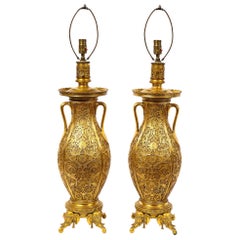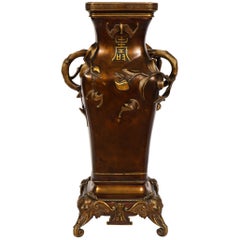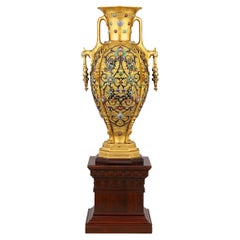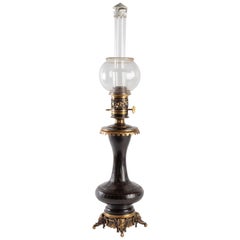Edouard Lievre Vases
2
to
2
2
2
2
2
Height
to
Width
to
2
2
2
2
2
1,027
542
394
357
Creator: Edouard Lievre
Pair of French Japonisme Ormolu Vases E. Lièvre, Executed by F. Barbedienne
By Edouard Lievre, Ferdinand Barbedienne
Located in New York, NY
An important and monumental pair of very fine 19th century French Japonisme/Orientalist ormolu vases designed by Edouard Lièvre and Executed by Ferdinand Barbedienne. Each body with an oval shape, finely sculpted in a floral design, fringed by orientalist style handles with cartouches, the neck surmounted by a circular pierced scrolling dragon frieze. Each vase resting on a group of four orientalist style jeweled elephant...
Category
1870s French Japonisme Antique Edouard Lievre Vases
Materials
Bronze
Antique French Bronze Orientalist Style Vase; E. Lievre for the Chinese Market
By Edouard Lievre
Located in New York, NY
This unique French bronze orientalist style vase by Edouard Lievre made for the Chinese market has been exceptionally handcrafted and patinated with gold highlights. Included on the ...
Category
Late 19th Century French Japonisme Antique Edouard Lievre Vases
Materials
Bronze
Related Items
Antique Japonisme French Baccarat Glass Bronze Vase
By Baccarat
Located in New York, NY
An antique French Baccarat glass vase with a fluted mouth. The vase is adorned with hand painted floral and foliage motifs in the Asian man...
Category
19th Century French Antique Edouard Lievre Vases
Materials
Bronze
Ancient Solid Bronze Vase with Chinese or Japanese Elephants
Located in Palermo, Sicily
Ancient solid bronze vase with Chinese or Japanese elephants
Category
Early 1700s Japanese Japonisme Antique Edouard Lievre Vases
Materials
Bronze
Ferdinand Barbedienne, A French Ormolu and Champleve Enamel Jardiniere, C. 1870
By Louis-Constant Sevin, Ferdinand Barbedienne
Located in New York, NY
Ferdinand Barbedienne, A French Ormolu and Champleve Enamel Jardiniere, C. 1870, The Design Attributed to Louis Constant Sevin.
An exceptional qualit...
Category
19th Century French Napoleon III Antique Edouard Lievre Vases
Materials
Bronze, Enamel, Ormolu
No Reserve
H 5 in W 8 in D 5 in
Pair of 19th Century Rococo Ormolu & Griotte Marble Candelabra, Barbedienne
By Ferdinand Barbedienne
Located in Los Angeles, CA
A fine pair of French 19th century Rococo Revival style gilt bronze and Rouge Griotte marble six-light candelabra attributed to Ferdinand Barbedienne (French, 1810-1892) After a mode...
Category
Late 19th Century French Rococo Revival Antique Edouard Lievre Vases
Materials
Griotte Marble, Bronze, Ormolu
Vintage Midcentury Chinese Bronze Brutalist Style Vase Vessel
Located in San Diego, CA
Beautiful and unique Chinese bronze cast archaic style ritual vessel or vase. This beautiful piece is ornate in design with simple lines. The vessel stretches outwards while keeping ...
Category
1960s Chinese Chinoiserie Vintage Edouard Lievre Vases
Materials
Bronze
F. Barbedienne, A Suite of Three French Ormolu and Champleve Enamel Jardinieres
By Ferdinand Barbedienne
Located in New York, NY
Ferdinand Barbedienne, An Exquisite Suite of Three French Ormolu and Champleve Enamel Jardinieres / Garniture C. 1870, The Design Attributed to Louis Constant Sevin.
Comprising of t...
Category
19th Century French Napoleon III Antique Edouard Lievre Vases
Materials
Bronze, Enamel, Ormolu
H 5 in W 8 in D 5 in
French Empire Style Bronze and Crystal Vases
Located in West Palm Beach, FL
This pair of French Empire vases date from the 19th century and are of exceptional quality. Unfortunately one of the cut crystal vase has been crac...
Category
Late 19th Century French Empire Antique Edouard Lievre Vases
Materials
Crystal, Bronze
Pair of Chinese Bronze Vases
Located in New York, NY
Pair of circa 1930's bronze Chinese vases depicting dragons.
Measurements:
Height: 10"
Diameter: 6"
Category
1930s Chinese Vintage Edouard Lievre Vases
Materials
Bronze
Ferdinand Barbedienne, a French Ormolu and Champleve Enamel Jardiniere, C. 1870
By Louis-Constant Sevin, Ferdinand Barbedienne
Located in New York, NY
Ferdinand Barbedienne, A French Ormolu and Champleve Enamel Jardiniere, C. 1870, The Design Attributed to Louis Constant Sevin.
An exceptional qualit...
Category
19th Century French Napoleon III Antique Edouard Lievre Vases
Materials
Bronze, Ormolu, Enamel
Pair of Porcelain Vases Ormolu-Mounted in Lamps by Gagneau Paris XIXth Century
By Gagneau Paris
Located in Saint-Ouen, FR
Pair of large Japanese Porcelain Cone Shape Vases with Imari decoration
Important mounts in ormolu and gilded metal, the base decorated with a laurel wreath, the upper part of falling leaves and a frieze of knotted ribbon.
The mounts signed Gagneau, 115 R. Lafayette.
Circa 1860
With their original aluminium bulb cover and original gilding
Vase it self Height 47 cm
The Gagneau Company is one of the most famous lighting factories in Paris in the nine-teenth century, established in 1800 at 25 rue d'Enghien in Paris and later at 115 rue de Lafayette. She has participated in many exhibitions throughout this century. She began in 1819 with the Exposition des Produits de l'Industrie and later participated in the Universal Exhibitions where she was part of the jury in the category of art bronzes (class 25) at the Universal Exhibition in Paris in 1889.
"Imari" was simply the trans-shipment port for Arita wares, from where they went to the for-eign trading outposts at Nagasaki. It was the kilns at Arita which formed the heart of the Japanese porcelain industry.
Arita's kilns were set up in the 17th century, after kaolin was discovered in 1616. A popular legend attributes the discovery to an immigrant Korean potter, Yi Sam-Pyeong (1579–1655), although most historians consider this doubtful. After the discovery, some kilns began to produce revised Korean-style blue and white porcelains, known as Early Imari, or "Shoki-Imari".
In the mid-17th century, there were also many Chinese refugees in northern Kyushu due to the turmoil in China, and it is said that one of them brought the overglaze enamel coloring technique to Arita. Thus Shoki-Imari developed into Ko-Kutani, Imari, and later Kakiemon, which are sometimes taken as a wider group of Imari wares. Ko-Kutani was produced around 1650 for both export and domestic market.Kutani Ware is characterized by vivid green, blue, purple, yellow and red colors in bold designs of landscapes and nature. Blue and white porcelain pieces continued to be produced and they are called Ai-Kutani. Ko-Kutani Imari for the export market usually adopted Chinese design structure such as kraak style, whereas Ai-Kutani for the domestic market were highly unique in design and are ac-cordingly valued very much among collectors.
Ko-Kutani style evolved into Kakiemon-style Imari, which was produced for about 50 years around 1700. Kakiemon was characterized by crisp lines, and bright blue, red and green designs of dramatically stylized floral and bird scenes. Imari achieved its technical and aes-thetic peak in the Kakiemon style, and it dominated the European market. Blue and white Kakiemon is called Ai-Kakiemon. The Kakiemon style transformed into Kinrande in the 18th century, using underglaze blue and overglaze red and gold enamels, and later additional colors.
Imari began to be exported to Europe when the Chinese kilns at Jingdezhen were damaged in the political chaos and the new Qing dynasty government halted trade in 1656–1684. Ex-ports to Europe were made through the Dutch East India Company, and in Europe the des-ignation "Imari porcelain" connotes Arita wares of mostly Kinrande Imari.
Export of Imari to Europe stopped in mid-18th century when China resumed export to Europe, since Imari was not able to compete against Chinese products due to high labor costs. By that time, however, both Imari and Kakiemon styles were already so popular among Eu-ropeans that the Chinese export porcelain copied both, a type known as Chinese Imari. At the same time, European kilns, such as Meissen and English potteries such as Johnson Bros. and (Royal) Crown Derby, also imitated the Imari and Kakiemon styles.
Export of Imari surged again in late 19th century (Meiji era) when Japonism flourished in Europe.Thus, in the western world today, two kinds of true Japanese Imari can...
Category
1880s French Japonisme Antique Edouard Lievre Vases
Materials
Bronze
H 38.59 in Dm 10.24 in
Pair of Trumpet-Shaped Byzantines Vases, L.C. Sevin&F. Barbedienne, France, 1880
By Louis-Constant Sevin, Ferdinand Barbedienne
Located in PARIS, FR
Signed F. Barbedienne
A pair of charming trumpet-shaped vases in gilt bronze with a polychrome cloisonné enamel decoration, one blue and the other green and red. They feature two annular handles and stand on four feet surmounted by a stylized palm. The vases are ornated with a Byzantine decoration.
The high quality of the enamel is typical of Barbedienne’s production. It enhances this pair of vases especially with the wide range of colours used to create the decoration. The enamel is smooth and shiny and shows many shades to form the Byzantine decoration. The partitioned cloisonné is finely engraved and contributes to the decoration by adopting vegetal and foliage shapes.
The Model
These two vases can be linked to a vase presented by Ferdinand Barbedienne at the 1862 London Universal Exhibition and purchased at this time by the South Kensington Museum (now the Victoria and Albert Museum, London, Inv. 8026-1862). This vase has on its belly a polychrome cloisonné enamel decoration standing out against a turquoise background as show these vases. This decoration, called Byzantine, covers all the vase with coloured arabesques and scrolls. It rests on four claw feet with lion heads from a design near of our vases.
Barbedienne and the Cloisonné Enamel
Ferdinand Barbedienne continously innovated and he revived the use of enamel on art works during the second half of the 19th century. The Sèvres Manufacture enamel workshop had ever tried it in 1854-1855, but Barbedienne was the one who succeeded to join enamel to an industrial decorative objects production. From 1858 “At Mr Barbedienne’s, enamels in copper ornaments have got their former prestige back” (Les bronzes de la Maison Barbedienne, C. Simon, in L’Art du XIXe siècle, 1858, n°21, p. 252). The Barbedienne Company had now an enamel workshop where objects ornamented with oriental style or medieval style enamels were made. Four years after, Barbedienne’s cloisonné...
Category
1880s French Other Antique Edouard Lievre Vases
Materials
Bronze, Enamel
H 9.45 in Dm 3.75 in
Bronze Chinese Dragon Vase
Located in San Diego, CA
Wonderfully detailed bronze Chinese dragon vase, circa mid-20th century.
Category
Mid-20th Century Chinese Chinese Export Edouard Lievre Vases
Materials
Bronze
Previously Available Items
World's Fair Bronze Vase By Barbedienne
By Ferdinand Barbedienne, Edouard Lievre
Located in New Orleans, LA
This monumental gilt-bronze and enamel vase marries the imaginative designs of Édouard Lièvre’s ‘le style japonais et chinois’ and the technical prowess of renowned bronzier Ferdinan...
Category
19th Century French Japonisme Antique Edouard Lievre Vases
Materials
Bronze, Enamel
Antique Bronze Ming Vase, Pumped Up by Edouard Lièvre in Oil Lamp
By Edouard Lievre
Located in Saint-Ouen, FR
Ming vase in antique bronze, mounted by Edouard Lièvre in oil lamp, bronze mounted by Lièvre, from the Napoleon III period
Measures: H 77cm, L 19cm.
Category
17th Century Chinese Napoleon III Antique Edouard Lievre Vases
Materials
Bronze
Edouard Lievre vases for sale on 1stDibs.
Edouard Lievre vases are available for sale on 1stDibs. These distinctive items are frequently made of metal and are designed with extraordinary care. There are many options to choose from in our collection of Edouard Lievre vases, although gold editions of this piece are particularly popular. If you’re looking for additional options, many customers also consider vases by Theodore Deck, and Cristalleries De Baccarat. Prices for Edouard Lievre vases can differ depending upon size, time period and other attributes — on 1stDibs, these items begin at $26,250 and can go as high as $185,360, while a piece like these, on average, fetch $138,500.





